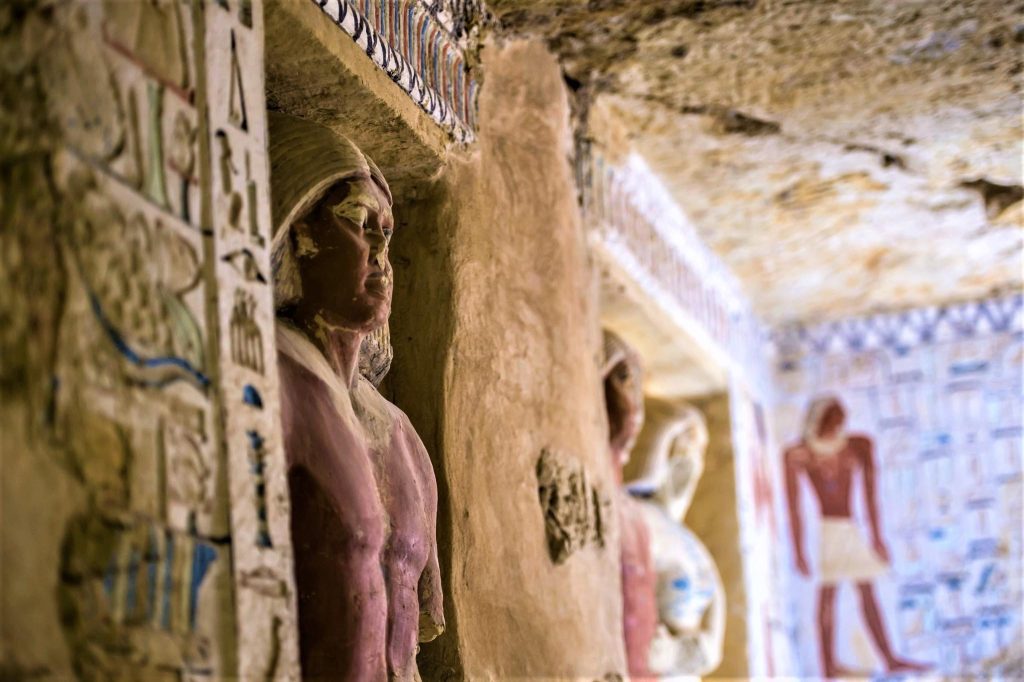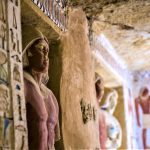Wahty Tomb Saqqara Complex
Who is Wahty?
Wahtye (fl. 25th-century BC) was a high-ranking priest and official who served under King Neferirkare during the Fifth Dynast of Egypt Based on his skull, he was probably 35-years-old when he died.

The Tomb discovered in November 2018, Tomb of ancient Egyptian high priest remained untouched for 4500 years. The tomb is simply breathtaking, found in Saqqara complex nearCairo.
The tomb is 10 metres (33 ft) long from north to south, and 3 metres (9.8 ft) wide from east to west
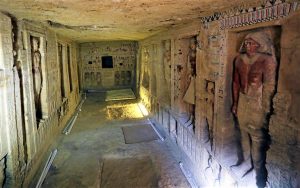
The tomb filled with colored hieroglyphs and 55 statues.Decorative scenes show the owner a royal priest with his mother, wife and other relatives.The discovery one of its kind in last decade.Beneath the tomb archaeologists discovered 5 unopened shafts hidden, one of which holds the owner sarcophagus. Wahtye served under King Neferirkare 25th century BC during the 5th dynasty.

The tomb in two levels, there are 24 statues on upper level and 31 on the lower. All of which for the prominent peoples or Gods, with some been on life size and other 3 foot or 1 meter tall.
The hieroglyphs discovered in the tomb often mentioned his mother Merit Min mean the lover of god Min, God of fertility in ancient time.

His wife was called Weret Ptah whose name means the greatest of god Ptah, Ptah as we know the creator god associated with the ancient Egyptian capital Memphis. Despite the fact that nearly 4500 years of past since the tomb was sealed still contain numerous painting with color preserved.
The painting shows Egyptian daily life with people engaged in variety of tasks such as drinking, cooking and building.
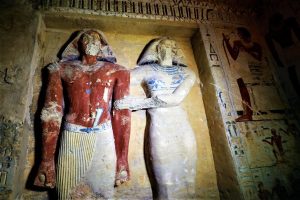
Secrets of the Saqqara Tomb
On October 28, 2020, Netflix premiered a 120 minute documentary in 190 countries with over 30 subtitles about the discovery of Wahtye’s tomb called “Secrets of the Saqqara Tomb”. This documentary explores the discovery of the tomb of Wahtye, an Egyptian priest, and the archaeological excavations at the Saqqara necropolis in Egypt.
One of the most striking aspects of “Secrets of the Saqqara Tomb” is its meticulous attention to detail. The documentary brings the archaeological process to life, immersing the audience in the painstaking work of the dedicated team of experts as they excavate and preserve the tomb’s contents. Viewers witness the delicate cleaning of vividly painted murals, the deciphering of hieroglyphs, and the delicate handling of fragile artifacts. This meticulous approach not only showcases the dedication of the archaeologists but also underscores the importance of preserving and understanding Egypt’s rich cultural heritage.
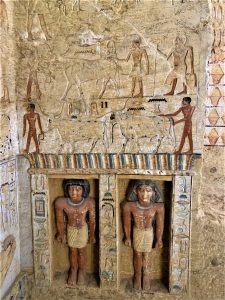
The film also delves into the life and times of Wahtye, shedding light on his role as a priest and the significance of his burial. Through the intricate inscriptions on the tomb’s walls and the artifacts found within, the documentary paints a vivid picture of Wahtye’s world. It highlights the intricate rituals and beliefs that accompanied death in ancient Egypt, including the importance of ensuring a prosperous afterlife.
“Secrets of the Saqqara Tomb” serves as a reminder of the enduring allure of ancient Egypt. The fascination with this civilization has transcended centuries, captivating the imaginations of people worldwide. The documentary captures this universal fascination and showcases the enduring appeal of Egyptology as a field of study.
One of the film’s strengths lies in its ability to bridge the gap between the distant past and the present day. As viewers are transported back in time through the tomb’s artifacts and inscriptions, they are also introduced to the modern-day archaeologists who are passionately dedicated to unraveling the mysteries of ancient Egypt. Their enthusiasm and commitment are infectious, inviting the audience to share in their excitement as each new discovery is made.
The documentary’s international appeal is further enhanced by the inclusion of subtitles in over 30 languages, making it accessible to a global audience. This thoughtful consideration for viewers from diverse linguistic backgrounds underscores the universality of the film’s themes and the enduring relevance of Egypt’s ancient history.
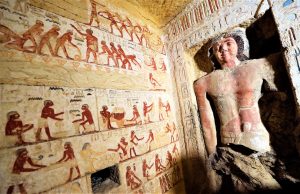
Saqqara: The Land of Tombs and Pyramids
Saqqara, often referred to as Sakkara or Saccara, is an expansive archaeological site that served as a burial ground for thousands of years. Its historical significance is immense, as it contains numerous tombs, mastabas (flat-roofed, rectangular structures), and the iconic Step Pyramid of Djoser, considered the world’s oldest stone-cut monument.
The Saqqara Complex, located on the west bank of the Nile River, was a focal point of Egyptian funerary culture during the Old Kingdom (c. 2686–2181 BCE). This period marked the zenith of pyramid construction and the development of monumental tombs for the elite.
The Discovery of the Wahtye Tomb
The story of the Wahtye Tomb begins in December 2018 when a team of Egyptian archaeologists, led by Dr. Mostafa Waziri, discovered the tomb buried beneath the desert sands. This remarkable find quickly gained international attention due to its well-preserved condition and rich artistic adornments.
The tomb was unearthed in the pyramid field of Saqqara, an area known for housing tombs of high-ranking officials and nobles from the Old Kingdom. Inscriptions on the tomb’s walls identified its owner as Wahtye, a priest and high-ranking official during the reign of Pharaoh Neferirkare Kakai, who ruled during the Fifth Dynasty (c. 2494–2345 BCE).

The Splendor of the Wahtye Tomb
The Wahtye Tomb, officially designated as “Tomb of Wahtye,” is a masterpiece of Old Kingdom funerary art and architecture. Its interior offers a vivid glimpse into the beliefs, daily life, and aspirations of the elite during this ancient period.
Architectural Features
The tomb consists of a superstructure and a complex of subterranean chambers. The superstructure is a rectangular mastaba made of mudbrick and limestone casing stones, a typical design for Old Kingdom tombs. However, it is the interior of the tomb that truly captivates visitors.
Colorful Wall Reliefs
Upon entering the Wahtye Tomb, visitors are greeted by stunning wall reliefs that have retained their vivid colors for millennia. These intricate artworks depict scenes from Wahtye’s life, including images of him and his family, agricultural scenes, offerings to the deceased, and even scenes of daily life such as fishing and hunting.
One of the most prominent scenes is the depiction of Wahtye himself seated at an offering table, receiving offerings from his family members. This scene not only showcases the opulence of the tomb’s owner but also emphasizes the importance of the afterlife and the continuation of familial bonds beyond death in ancient Egyptian belief.
The quality and detail of the reliefs are exceptional, highlighting the skill and craftsmanship of the artisans of the time. The vibrant colors, including reds, blues, and yellows, are a testament to the mastery of ancient Egyptian artists in creating long-lasting pigments.
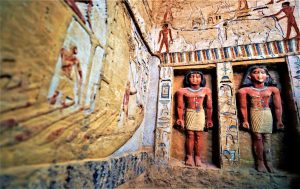
Hieroglyphic Inscriptions
The walls of the tomb are adorned with hieroglyphic inscriptions that provide valuable information about Wahtye, his titles, and his family. These inscriptions offer insights into his role as a priest and his high-ranking position within the royal administration. They also mention his mother, Merit Meen, and his wife, Weret Ptah.
The inscriptions not only serve as historical records but also reinforce the tomb’s function as a place for the veneration of the deceased and the offering of prayers and rituals.
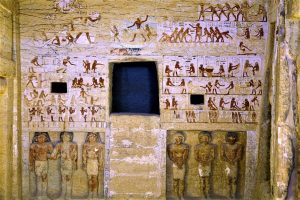
Unique Burial Chamber
The burial chamber of the Wahtye Tomb is a remarkable feature that sets it apart from many other Old Kingdom tombs. It contains a rectangular limestone sarcophagus, a feature more commonly found in royal tombs of the period. The presence of this sarcophagus indicates Wahtye’s elite status and the importance attached to his burial.
The Significance of the Wahtye Tomb
The discovery of the Wahtye Tomb has offered archaeologists and Egyptologists valuable insights into various aspects of ancient Egyptian culture and society during the Old Kingdom.
Artistic Mastery
The well-preserved and vibrantly colored wall reliefs inside the tomb are a testament to the artistic talents of the period. They provide a visual record of the daily life, customs, and beliefs of the elite class during the Old Kingdom, contributing to our understanding of this fascinating era.
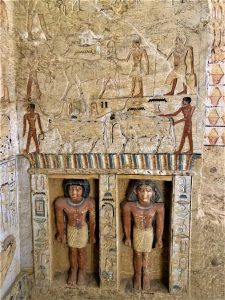
Social Hierarchy
Wahtye’s tomb serves as a historical document that confirms the existence of a well-structured social hierarchy in ancient Egypt. His prominent role as a priest and high-ranking official reflects the importance of religious and administrative positions in the society of the time.
Funerary Beliefs
The Wahtye Tomb offers a glimpse into the elaborate funerary beliefs of the Old Kingdom Egyptians. The scenes of offerings and prayers depicted on the walls reflect the deep-seated belief in an afterlife and the need to ensure a comfortable and prosperous existence beyond death.
Preservation and Conservation
The meticulous preservation of the tomb’s wall paintings and inscriptions highlights the importance of ongoing efforts to protect and conserve Egypt’s cultural heritage. The Wahtye Tomb serves as a reminder of the fragility of these ancient treasures and the need for continued conservation efforts.

